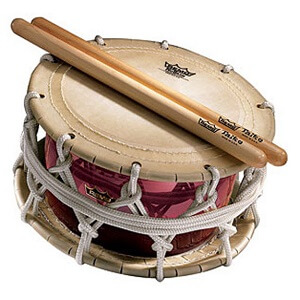Shime Daiko
 This stick-beaten Japanese shime-daiko double-headed membranophone uses a bolt-tensioning system that is a recently introduced alternative to a traditional rope-tensioning system. Shime-daiko using the traditional rope system are used in folk music (first audio clip), Buddhist and Shinto religious practices and festivals, court music and dance (gagaku and bugaku), noh theatre, nagauta, and kabuki theatre. The bolt design variant is favored in the relatively recent kumi-daiko (drum ensemble) phenomenon that developed in late 20th century Japan.
This stick-beaten Japanese shime-daiko double-headed membranophone uses a bolt-tensioning system that is a recently introduced alternative to a traditional rope-tensioning system. Shime-daiko using the traditional rope system are used in folk music (first audio clip), Buddhist and Shinto religious practices and festivals, court music and dance (gagaku and bugaku), noh theatre, nagauta, and kabuki theatre. The bolt design variant is favored in the relatively recent kumi-daiko (drum ensemble) phenomenon that developed in late 20th century Japan.
The shell/body of this shime-daiko uses butcher-block construction. Several slats of hardwood are glued together to create the cylindrical shell, which is then turned on a lathe to achieve uniform walls. Each of the two heads is made from a circle of thick tanned cowhide the diameter of which is several inches greater than that of the heavy metal hoop it is lapped over (see first detail image). The excess hide is turned back toward the center of the head and terminates just short of where the rim of the drum will be situated. The two layers of hide are sewn together at this point with two rows of stitches. Another row of stitching, interrupted by holes drilled through the hide for the tension bolts, is situated just inside the head's hoop. The heads are attached to the shell with a bolt tensioning system. The top of each of the ten bolts used to secure each head is curved to hook over the head hoop. Their bottom ends are threaded to accept a nut after the bolt has passed through a hole in a heavy gauge metal ring that orbits the shell at its midpoint (this ring does not make contact with the shell; it is suspended by alternating bolts linked to the upper and lower heads--see second detail image). It is against this ring that the nuts are tightened, making possible adjustments in the amount of tension being applied to the heads. The drum rests on a high stand made of oak. Two thick wooden dowels are used as beaters.
It is extremely difficult to pinpoint the origin of most Japanese taiko due to extensive first-millennium CE cultural interaction between Japan, China, and Korea. If nothing else, the association between shime-daiko type drums and Japan's court music implies that the drum has been around at least since the eighth century CE.